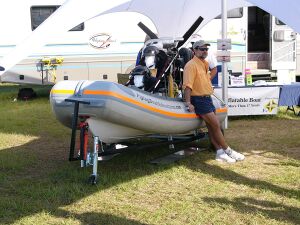Engineering:Polaris FIB
| AM-FIB | |
|---|---|

| |
| Polaris FIB hull and motor on display at Sun 'n Fun 2004 | |
| Role | Ultralight trike |
| National origin | Italy |
| Manufacturer | Polaris Motor New Polaris 2020 S.L. |
| Introduction | mid-1980s |
| Status | temporarily suspended |
| Variants | Polaris AM-FIB |
The Polaris FIB ("Flying Inflatable Boat") is an Italian flying boat ultralight trike, that was designed and produced by Polaris Motor of Gubbio. The aircraft was introduced in the mid-1980s and remained in production until about 2014. It was supplied as a complete ready-to-fly-aircraft.[1][2]
It is now produced by New Polaris 2020 S.L. of Tenerife, Canary Islands, Spain .[3]
Design and development
The FIB complies with the Fédération Aéronautique Internationale microlight category, including the category's maximum gross weight of 450 kg (992 lb). The FIB has a maximum gross weight of 406 kg (895 lb).[1][2]
The aircraft features a cable-braced hang glider-style high-wing, weight-shift controls, a two-seats-in-tandem open cockpit, an inflatable boat hull and a single engine in pusher configuration. The FIB has no wheeled landing gear, but as a result of customer demand it was later developed into the amphibious Polaris AM-FIB.[1]
The FIB's single surface wing is made from bolted-together aluminum tubing and covered in Dacron sailcloth. The 11.15 m (36.6 ft) span wing is supported by a single tube-type kingpost and uses an "A" frame weight-shift control bar. The powerplant is a twin cylinder, liquid-cooled, two-stroke, dual-ignition 64 hp (48 kW) Rotax 582 engine.[1]
The aircraft has an empty weight of 216 kg (476 lb) and a gross weight of 406 kg (895 lb), giving a useful load of 190 kg (419 lb). With full fuel of 40 litres (8.8 imp gal; 11 US gal) the payload is 161 kg (355 lb).[1][2]
The company continued to develop the design and in 2010 introduced a new hull shape to increase performance in the water and in the air.[1]
Dimitri Delemarie, writing in The World Directory of Leisure Aviation 2011-12, said of the design, "It will never win any speed records, but if there were an award for fun, it would be right up there at the top."[1]
Operational history
The FIB is used by a number of government operators, including police and coastguards.[2]
Variants
In the early 2000s the company offered a version with the same wing, but without a boat hull, using a conventional minimalist trike frame mounted on wheeled landing gear or optionally skis. Even though it did not have a boat hull it was still marketed under the FIB name.[2]
Specifications (FIB)
Data from Bayerl[1]
General characteristics
- Crew: one
- Capacity: one passenger
- Wingspan: 11.15 m (36 ft 7 in)
- Wing area: 19.6 m2 (211 sq ft)
- Empty weight: 216 kg (476 lb)
- Gross weight: 406 kg (895 lb)
- Fuel capacity: 40 litres (8.8 imp gal; 11 US gal)
- Powerplant: 1 × Rotax 582 twin cylinder, liquid-cooled, two stroke aircraft engine, 48 kW (64 hp)
- Propellers: 3-bladed composite
Performance
- Maximum speed: 80 km/h (50 mph, 43 kn)
- Cruise speed: 70 km/h (43 mph, 38 kn)
- Stall speed: 48 km/h (30 mph, 26 kn)
- Rate of climb: 4.5 m/s (890 ft/min)
- Wing loading: 20.7 kg/m2 (4.2 lb/sq ft)
References
- ↑ 1.0 1.1 1.2 1.3 1.4 1.5 1.6 1.7 Bayerl, Robby; Martin Berkemeier; et al: World Directory of Leisure Aviation 2011-12, page 218. WDLA UK, Lancaster UK, 2011. ISSN 1368-485X
- ↑ 2.0 2.1 2.2 2.3 2.4 Bertrand, Noel; Rene Coulon; et al: World Directory of Leisure Aviation 2003-04, page 107. Pagefast Ltd, Lancaster UK, 2003. ISSN 1368-485X
- ↑ New Polaris 2020 S.L. (2020). "Let's Fly Again". newpolaris2020.com. https://newpolaris2020.com/web/.
External links
 |

